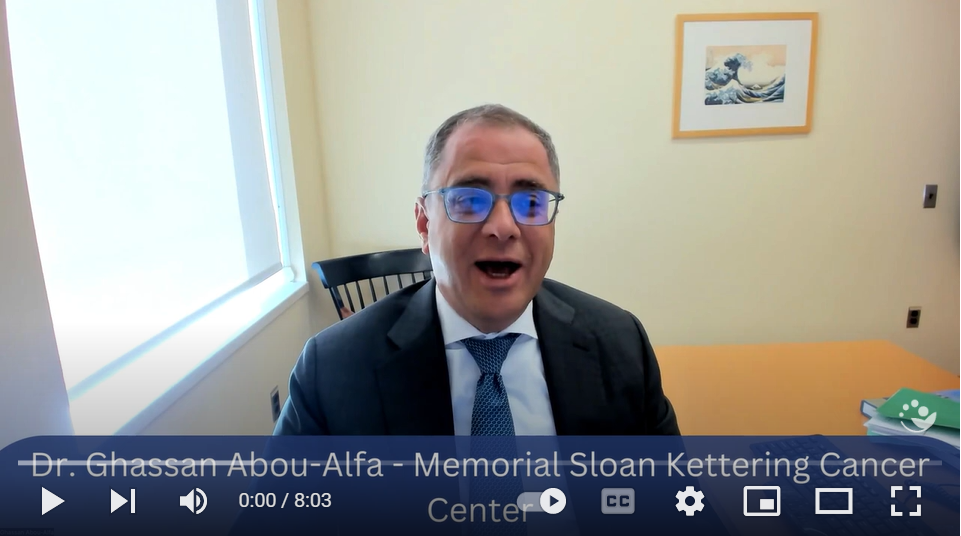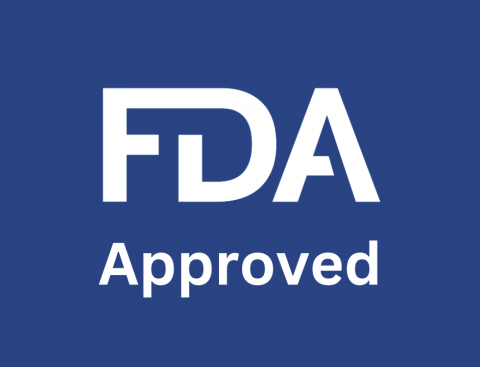Dr. Ghassan Abou-Alfa of Memorial Sloan Kettering Cancer Center shares a recent abstract from ASCO GI, IMBRAVE-151, A Phase II, randomized, double-blind placebo-controlled study of atezolizumab with or without bevacizumab in combination with cisplatin plus gemcitabine in patients with untreated, advanced biliary tract cancer.
Transcription:
“Hello everybody, and thanks to the Binaytara Foundation for permitting me to discuss an update on an abstract from GI ASCO. It’s a great honor and a delight and I was tasked to present on the phase II randomized study of the placebo-controlled study of bevacizumab in combination with atezolizumab with gemcitabine and cisplatin in patient with advanced Biliary Tract Cancer, or what we have seen as called the IMBRAVE-151. And remember, it’s not 150, it’s 151, it’s biliary cancer, with the add-on of bevacizumab, atezolizumab, gemcitabine, cisplatin. Understandably, the great presentation by Dr. El-Khoueiry, a great colleague of ours, was to give a background about Biliary Tract Cancer and of course note that the current standard of care is the TOPAZ-1 study, which is gemcitabine, cisplatin plus durvalumab, making an argument for some other add-on of the anti-angiogenic, being the bevacizumab. This is of course, we all know that in the cancer immunity cycle, the add-on of anti-VEGF could enhance further anti-PD1, anti-PDL1, and thus the study that offered for patients with confirmed diagnosis of biliary cancer with good performance status, measurable disease, and of course with endoscopy, which is critical in view of the bevacizumab. These patients were randomized to either the atezolizumab, plus bevacizumab, plus gemcitabine, plus the cisplatin, with the understanding that the gemcitabine and cisplatin will be stopped after cycle 9 which is equivalent to about like six months or so. And this is compared to patients to receive atezolizumab plus placebo plus gemcitabine and cisplatin. Very important here to pause for a second, this is a study looking at two experimental arms, one of them is Gem-Cis plus atezolizumab, bevacizumab, and the other one is Gem-Cis plus atezolizumab plus placebo.
So, we’re technically comparing the add-on of atezolizumab plus bevacizumab and the add-on of the atezolizumab plus placebo. You notice that I made very clear that I said the word “add” the other because it’s not “or” because this is not a comparison, this is a phase II trial and the colleagues who presented, Dr. El-Khoueiry was very clear, we’re not comparing the arms, we’re simply just citing them. I want you all just to think about when you have a phase II study as being like two studies in one per se. With this, the eligibility criteria were, of course, the standard, patients with the disease, independent of its intra-hepatic, extra-hepatic, or gallbladder cancer. In addition to that, a measurable disease, good performance stats, good liver functionality, and, of course, the exclusion criteria was anything which has a recurrence less than six months after surgery or adjuvant therapy. Of course, mixed cholangiocarcinoma/ACC was not eligible, neuropathy grade 2 or more was not eligible, and of course, any potential bleeding, and autoimmune diseases. The baseline characteristics of the two arms weren’t measurable, no need to go in the details of that, important to note though that about maybe 50+ percent of the patients had intrahepatological carcinoma, and at the same time, about 80% had metastatic disease. The study was quite distributed worldwide but had a little bit of a more presence in Asia than compared to other parts of the world, 40+ percent in Asia and the rest of the world about 57%.
The primary endpoint of study was PFS. The PFS for the atezolizumab, bevacizumab, plus gemcitabine, cisplatin was 8.3 months, for the atezolizumab plus placebo plus gemcitabine, cisplatin was 7.9 months and their stratified hazard ratio of 0.76. Again, please remember, it’s hard to compare those, it’s not really appropriate to compare those, but we clearly see that they were kind of like almost showing the same trend, which was reflected further in the progression-free survival subgroup analyses, not showing really any differentiation per se, even though as a Dr. El-Khoueiry pointed out when he presented, that maybe the patient who had prior surgery did fare better on the atezolizumab plus placebo and the patient with the PDL-1 category expression of more than 1% maybe it had more on the atezolizumab plus placebo. However, the secondary endpoint being response rate, showed the response equivalent in both arms, about 20+ percent, and in addition to that, this includes about 1% in regard to complete response, and of course, 18 or 20% of partial response. The duration of response was rather, again, noted to be relatively for the atezolizumab, bevacizumab shorter than for the atezolizumab plus placebo, 6 months versus 13, with the hazard ratio of 0.22 and overall survival, not much of a trend, about 24 months for the atezolizumab, bevacizumab plus gemcitabine and cisplatin, and 33 months for the gemcitabine and cisplatin plus atezolizumab plus placebo.
There was another effort which I would not spend time on but looked into, the exploratory analysis of the PFS in view of patient responses per se, even though I can tell that there’s not much difference per se over here. One classic scenario is I would like to see if there’s a crossing of the median survival in the CRBR and there was no crossing for atezolizumab, but please remember, by the time of the presentation, there were like three patients left on it, so it would not be something that will make any richer impact per se. Safety-wise, of course, the concern always in regard to potential bleeding with the add-on of the bevacizumab and of course the adverse events in regard to the use of the checkpoint inhibitors per se and not necessarily that anything stood out, but clearly the adverse events more than 20% were kind of more apparent on the Atezo-placebo in regard to anemia, on the other hand the neutropenia was equivalent in both at present, and add to this also the maintenance phase was rather equivalent in both of them. So, in respect to that, I conclude that the IMBRAVE-151 is a randomized study of the adding on of PDL1 plus VGF plus gemcitabine, cisplatin, and, in regard to PDL1 plus the gemcitabine, plus cisplatin, if anything the median progression free survival was similar in both arms. The six month rate was relatively higher in regard to the bevacizumab arm, the overall survival is not necessarily much of a difference. I would say this is probably still within the context of being a phase II clinical trial, it’s hard to compare, and remember the comparator will be what will happen compared to other checkpoint inhibitors, but more importantly what does it compare to in regard to the gemcitabine, cisplatin alone, which is not the standard of care anymore because the durvalumab add on in the Topaz 1 study were completed, improvement in survival as well. So, great listening to Dr. El-Khoueiry; I’m honored that I’m repeating some of the nice work that he presented, congratulations to the authors on that. But I would say for what to do in clinic, still the standard of care, gemcitabine, cisplatin plus durvalumab.”





